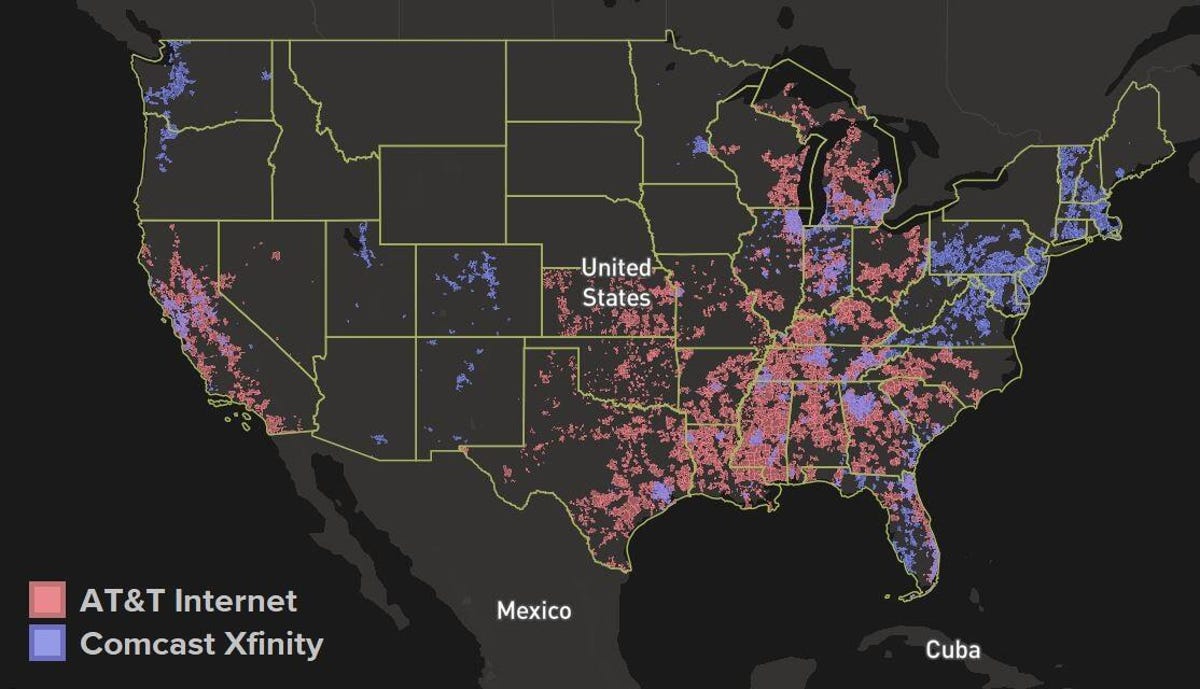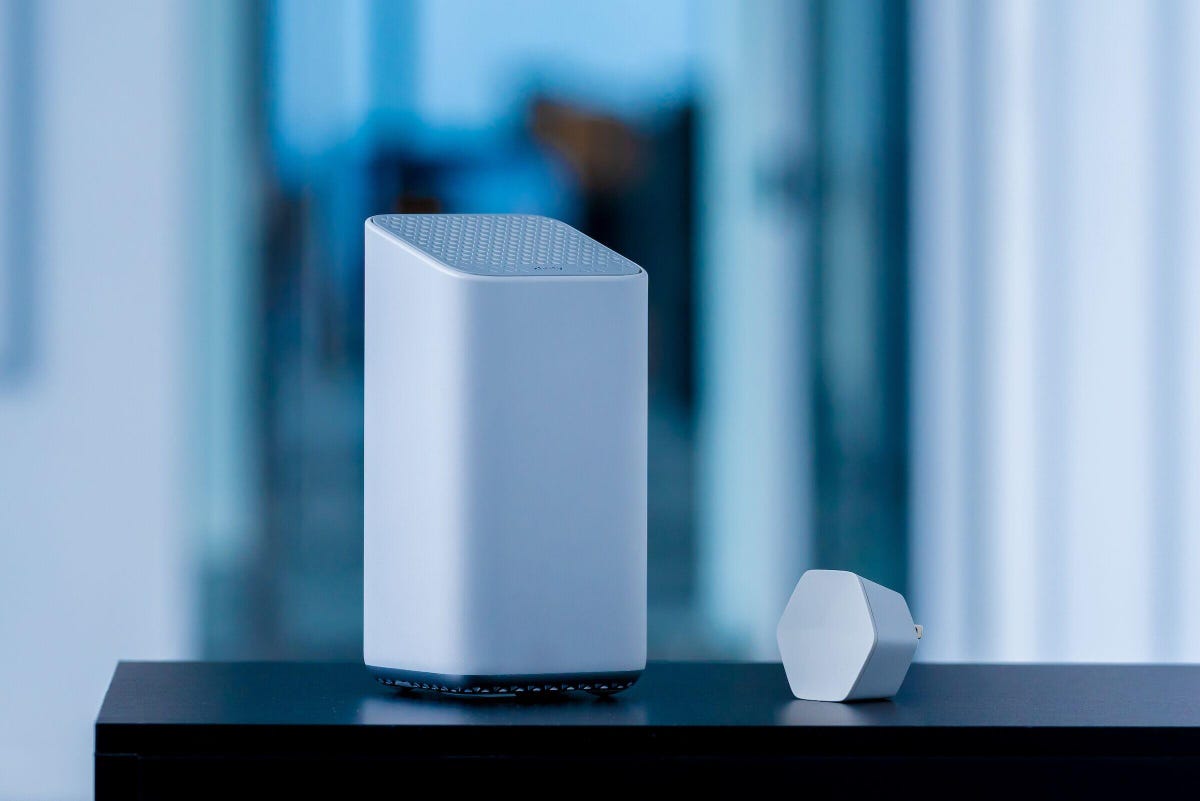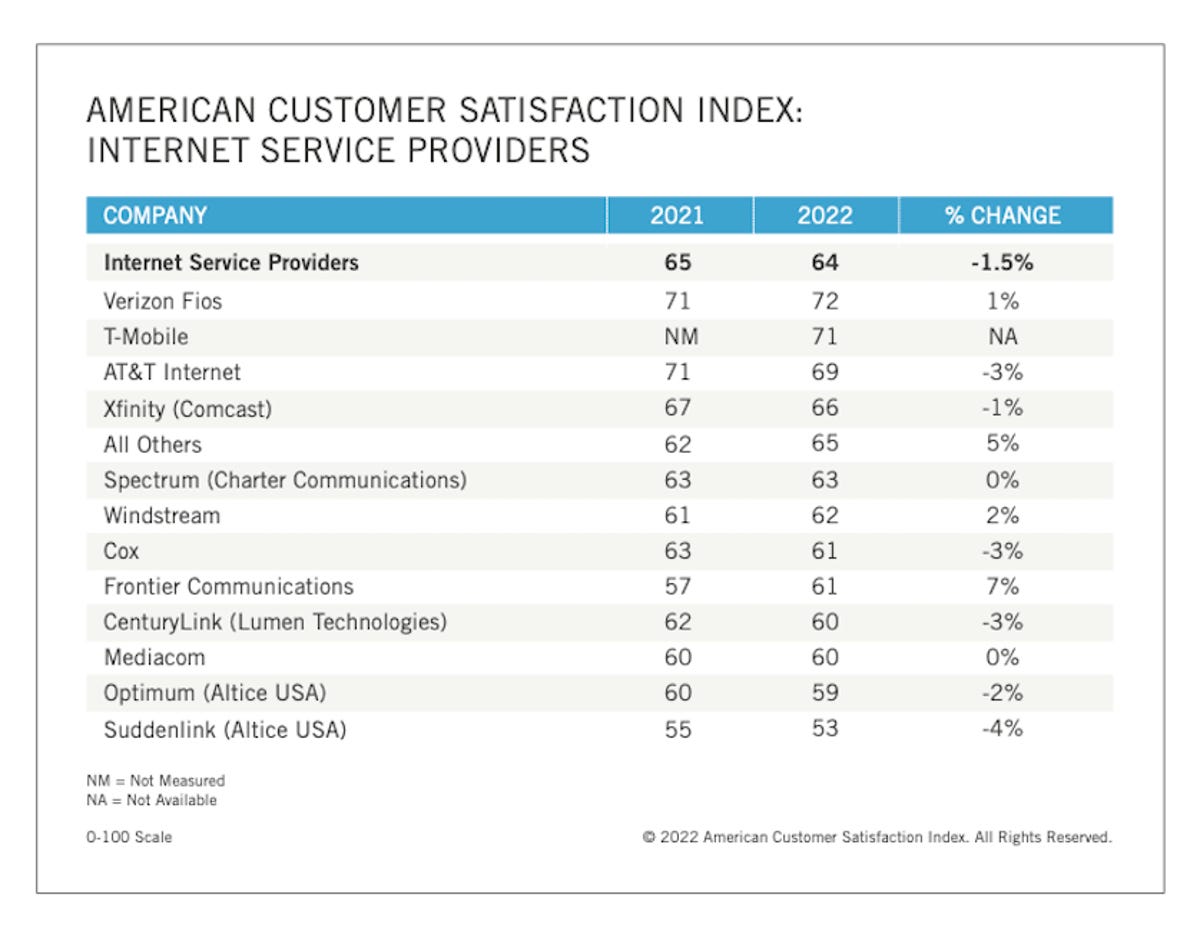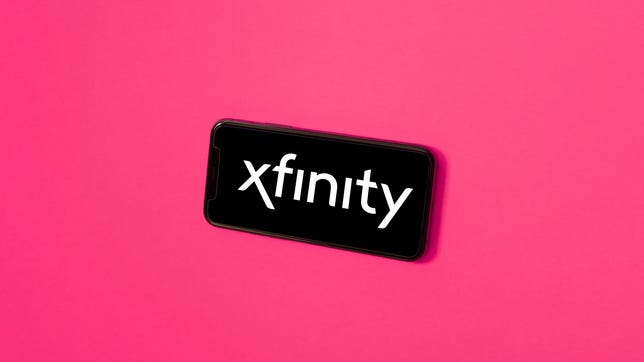[ad_1]
Available internet providers will vary by where you live, but if your choice comes down to AT&T or Comcast Xfinity, you’re in pretty good shape. Between AT&T’s fiber footprint and Comcast’s cable empire, both providers offer access to high speeds across a significant portion of their coverage maps. Both rank relatively well for customer service, too. Each company finished with an above-average rating among major internet providers in the most recent surveys from the American Customer Satisfaction Index and J.D. Power and Associates.
Which of these two internet service providers is the best fit for your home networking needs? Glad you asked — let’s take a close look at how they stack up and help you decide.
AT&T vs. Xfinity Overview
| AT&T | Xfinity | |
| Internet technology | DSL/fiber | Cable |
| Monthly price range | $55-$180 | $20-$300 |
| Speed range | 10-5,000Mbps | 50-6,000Mbps |
| Equipment costs | None | $14 per month (skippable) |
| Data cap | None | 1.2TB |
| Contract | None | 1 year |
| CNET review score | 7.4 | 7 |
Sarah Tew/CNET
AT&T boasts the most extensive fiber network of any provider and its fiber plans are hard to beat: 300Mbps starting at $55 per month, 500Mbps for $65 and gigabit service starting at just $80 per month. On top of that, over 100 AT&T cities nationwide are eligible for the company’s fastest fiber plans: 2Gbps for $110 and 5Gbps for $180. In all cases, the prices don’t automatically increase after a year, equipment is included in the monthly cost, and all plans have unlimited data and no contract requirements.
AT&T Internet, a copper-based service, and AT&T fixed wireless plans are more of a mixed bag as far as speeds and value, but still may be worth a look depending on where you live and what other internet options may be available. Unlike AT&T Fiber, you will have a data cap with both services and your price will increase after a year.
Sarah Tew/CNET
Xfinity has the largest cable network of any major provider, not to be outdone. Consequently, Xfinity and AT&T service areas overlap in many regions, particularly in the Southeast, Midwest and central California. Given a choice between the two, why choose Xfinity over AT&T?
Xfinity will offer more plan options and will likely offer the cheapest plan, though speeds with the said plan will be much lower than the lowest-priced AT&T Fiber plan. Just watch out for a price increase after 12 months, which could add as much as $50 to your bill depending on where you live and the plan you choose.
AT&T and Xfinity coverage maps compared

FCC/Mapbox
First, let’s take a look at where both providers offer service. A product of the nation’s largest cable provider, Xfinity Internet, is available in select regions across 39 states and Washington, DC, covering about one-third of the entire population of the US. Comcast splits that coverage map into three divisions — West, Central and Northeast. Each has its own set of speed tiers, prices and terms, which gets confusing. More on that in just a minute, after we get some coffee.
As for AT&T, the telecom company offers home internet plans in 21 states, with service covering much of the South, Midwest, and West Coast. Both providers may be available at your address in some parts of the country, including parts of Atlanta, Chicago, Detroit, Houston, Memphis, Miami and San Francisco.
Xfinity vs. AT&T: Plans, speeds and what you’ll pay
We hope you like charts. We’ve got a bunch of ’em.
Blame Comcast. With several different speed tiers and separate sets of prices and terms for each of its three main coverage regions, summing up the company’s internet offerings gets chart-drunk in a hurry. Just know that the price you pay will depend on what part of the country you live in (and if you live in the South, you’re lumped in with the Central division).
Xfinity internet plans (West division)
| Plan | Max speeds | First-year promo rate | Standard rate (after promo period) | Equipment fee | Data cap | Term agreement |
|---|---|---|---|---|---|---|
| Connect | 50Mbps download, 5Mbps upload | $20 | $50 | $14 gateway rental (skippable) | Yes (1.2TB) | 1 year |
| Connect More | 100Mbps download, 5Mbps upload | $40 | $60 | $14 gateway rental (skippable) | Yes (1.2TB) | 1 year |
| Fast | 300Mbps download, 10Mbps upload | $50 | $70 (after 24 months) | $14 gateway rental (skippable) | Yes (1.2TB) | None |
| Superfast | 600Mbps download, 15Mbps upload | $60 | $80 (after 24 months) | $14 gateway rental (skippable) | Yes (1.2TB) | None |
| Ultrafast | 900Mbps download, 20Mbps upload | $70 | $90 (after 24 months) | $14 gateway rental (skippable) | Yes (1.2TB) | None |
| Gigabit | 1,200Mbps download, 35Mbps upload | $80 | $100 (after 24 months) | $14 gateway rental (skippable) | Yes (1.2TB) | None |
| Gigabit Pro | 6,000Mbps download, 6,000Mbps upload | $300 | $300 | $20 gateway rental (required) | Yes (1.2TB) | 2 years |
Xfinity internet plans (Central division)
| Plan | Max speeds | First-year promo rate | Standard rate (after promo period) | Equipment fee | Data cap | Term agreement |
|---|---|---|---|---|---|---|
| Connect | 50Mbps download, 5Mbps upload | $25 | $49 | $14 gateway rental (skippable) | Yes (1.2TB) | 1 year |
| Connect More | 100Mbps download, 5Mbps upload | $40 | $69 | $14 gateway rental (skippable) | Yes (1.2TB) | 1 year |
| Fast | 300Mbps download, 10Mbps upload | $50 | $79 | $14 gateway rental (skippable) | Yes (1.2TB) | 1 year |
| Superfast | 600Mbps download, 15Mbps upload | $50 | $89 | $14 gateway rental (skippable) | Yes (1.2TB) | 1 year |
| Ultrafast | 900Mbps download, 20Mbps upload | $60 | $99 | $14 gateway rental (skippable) | Yes (1.2TB) | 1 year |
| Gigabit Extra | 1,200Mbps download, 35Mbps upload | $70 | $109 | $14 gateway rental (skippable) | Yes (1.2TB) | 1 year |
| Gigabit Pro | 6,000Mbps download, 6,000Mbps upload | $300 | $300 | $20 gateway rental (required) | Yes (1.2TB) | 2 years |
Xfinity internet plans (Northeast division)
| Plan | Max speeds | First-year promo rate | Standard rate (after promo period) | Equipment fee | Data cap | Term agreement |
|---|---|---|---|---|---|---|
| Performance Starter | 50Mbps download, 5Mbps upload | $65 | $65 | $14 gateway rental (skippable) | No | None required |
| Performance | 100Mbps download, 5Mbps upload | $84 | $84 | $14 gateway rental (skippable) | No | None required |
| Performance Pro | 300Mbps download, 10Mbps upload | $30 | $89 | $14 gateway rental (skippable) | No | 1 year |
| Blast! | 600Mbps download, 15Mbps upload | $60 | $94 | $14 gateway rental (skippable) | No | 1 year |
| Extreme Pro | 900Mbps download, 20Mbps upload | $70 | $99 | $14 gateway rental (skippable) | No | 1 year |
| Gigabit | 1,200Mbps download, 35Mbps upload | $80 | $104 | $14 gateway rental (skippable) | No | 2 years |
| Gigabit Pro | 6,000Mbps download, 6,000Mbps upload | $300 | $300 | $20 gateway rental (required) | No | 2 years |
The speed tiers themselves are pretty similar across all three Xfinity regions. For example, the entry-level Performance Starter plan nets you top download speeds of 50 megabits per second no matter where you live. Meanwhile, Comcast’s fastest plan, Gigabit Pro, cranks those downloads up to 6,000Mbps — that’s 6 gigabits per second — complete with upload speeds to match. In between those two are five other plans with speeds ranging from 100 to 1,200Mbps.
Pricing across the regions is much more varied. For instance, that entry-level 50Mbps Performance Starter plan will cost you $20-$25 per month in the West and Central divisions, but the cost jumps all the way up to $65 per month if you live in the Northeast. That’s an availability quirk, as in most parts of the Northeast, it’ll be the 300Mbps Performance Pro plan that’s actually the cheapest one available. It costs $40 per month, and availability depends upon your home address.
One constant? That Gigabit Pro plan. Across all three regions, the eye-popping multi-gigabit speeds come with an eye-popping price tag of $300 per month, plus a two-year service contract. The speeds are impressive at 2,000 or 6,000 depending on where you live, but that $300 price point is tough to get past.
Oh, right — service contracts. Comcast requires them with many of its plans, but not all of them, and like the prices, those contract requirements differ from region to region. The contract locks you in as a customer but also shields you from higher costs. That means that once your agreement is up, your monthly rate will go up — in some cases, by as much as $50 — but you’ll also be free to cancel service without penalty. If you don’t want a contract, you can pay the higher, post-contract price from the start.
AT&T home internet plans
| Plan | Max speeds | Promo price (first 12 months) | Regular monthly cost (after 12 months) | Equipment fee | Data Cap |
|---|---|---|---|---|---|
| AT&T Fixed Wireless | 25Mbps download, 1Mbps upload | $70 | $70 | None | 350GB |
| AT&T Internet 10 | 10Mbps download, 1Mbps upload | $55 | $70 | None | 1TB |
| AT&T Internet 18 | 18Mbps download, 1Mbps upload | $55 | $70 | None | 1TB |
| AT&T Internet 25 | 25Mbps download, 2Mbps upload | $55 | $70 | None | 1TB |
| AT&T Internet 50 | 50Mbps download, 10Mbps upload | $55 | $70 | None | 1TB |
| AT&T Internet 100 | 100Mbps download, 20Mbps upload | $55 | $70 | None | None |
| AT&T Fiber – Internet 300 | 300Mbps download, 300Mbps upload | $55 | $55 | None | None |
| AT&T Fiber – Internet 500 | 500Mbps download, 500Mbps upload | $65 | $65 | None | None |
| AT&T Fiber – Internet 1000 | 940Mbps download, 880Mbps upload | $80 | $80 | None | None |
| AT&T Fiber – Internet 2000 | 2Gbps download, 2Gbps upload | $110 | $110 | None | None |
| AT&T Fiber – Internet 5000 | 5Gbps download, 5Gbps upload | $180 | $180 | None | None |
Meanwhile, AT&T’s plans mercifully fit in a single chart because they offer the same prices, speeds and terms regardless of what part of the country you live in. Per the Federal Communications Commission, the company’s fiber plans are available to slightly less than one-third of residential customers. AT&T pegs the number of households with access to fiber at approximately 16 million, spanning over 100 metro areas. The company says it plans to expand fiber access to millions more homes by the end of 2023, including the rollout of its multi-gigabit plans.
For the rest, there’s AT&T Fixed Wireless, which uses a satellite mounted at your home to receive a wireless signal, and AT&T Internet plans, which use DSL copper cable connections in combination with the company’s fiber infrastructure to deliver service to people’s homes, albeit it at much slower speeds.
AT&T plans don’t come with service contracts, but your bill will go up after the promo period if you have DSL or fixed wireless. None of the plans will jump by more than $20, though, so the increase isn’t as steep as you might see with Comcast Xfinity.
What about 5G home internet? AT&T doesn’t currently offer cellular home internet plans as Verizon and T-Mobile do. Still, in March 2021, the company’s executive vice president of technology operations, Chris Samba, told CNET that it plans to roll out its own AT&T cellular broadband offering later in 2022. When it gets here, it’ll use a combination of LTE and 5G technology. We’ll update this space when we learn more.

You’ll need to add $14 per month to your Comcast bill to use the company’s xFi Gateway — but you can skip that fee by using your own modem and router.
Comcast
Fees, data caps and other sticking points
Let’s get back to the topic of your monthly bill because there’s more to consider than the baseline cost. Both providers will tack on taxes and monthly fees each month, and in some cases, you’ll also need to manage a data cap.
Additional fees
First, the fees. Like most providers, AT&T and Comcast Xfinity will charge you a bit extra each month if you don’t enroll in autopay or paperless billing, but those fees are easy enough to dodge. Just, you know, enroll in autopay and paperless billing. Problem solved.
The equipment fees are another story. With AT&T, you won’t need to pay extra to use AT&T’s Wi-Fi gateway. That’s included in the regular monthly fee. With Comcast Xfinity, the cost to rent the xFi Gateway is $14 per month. Still, you can bypass it by using your own equipment, provided it’s approved to work with Comcast, and you’re OK with the fact that Comcast will no longer be able to offer device-specific technical support.
Data caps
As for data caps, AT&T doesn’t use them with any of its fiber plans, so we’ll give it some credit. There is, however, a data cap for AT&T’s nonfiber plans, which is why we said just a little bit of credit.
Once you’ve used one terabyte of data (1,000GB) in a given month of service, the cap kicks in. You’ll start getting charged $10 for every additional 50GB of data that your home uses. That additional charge gets capped at $100, so once you’ve eaten up at least 500GB of extra data, AT&T just throws its hands up and says, “see you next month.” If you think you need unlimited data, you can upgrade your plan for an extra $30 per month to sidestep the data cap altogether, and you can also ditch the data cap by bundling your home internet with other AT&T services.
Another point of note: the data cap with AT&T Fixed Wireless is much lower, kicking in at 350GB. You’ll still get charged $10 for each additional 50GB of data you use, but AT&T caps the charge at $200 instead of $100. Be mindful of falling asleep during a Netflix binge, AT&T Fixed Wireless customers.
Xfinity, meanwhile, enforces the same data cap with every plan it offers. Specifically, you’ll need to keep your monthly Xfinity internet usage under 1.2TB of data. If you don’t, you’ll be charged $10 for every 50GB of excess data use, capped at $100.
In fairness, 1.2TB is a lot of data, but it’s not unreasonable to think that a busy household would occasionally need more. For example, on my network, where I work from home, stream plenty of movies in 4K, and live with a roommate who’s just as online as I am, we went through about 320GB of data here in the first nine days of the month. That put us on pace to use just over 1TB by the end of the month.
If you live with, say, two roommates — or with a whole family of internet users — then data caps like those might be something you’d want to steer clear of if you could.
Installation costs
AT&T charges $99 for professional, in-home installation, but self-installation kits are available in some cases, too. Check with the company to see if that’s an option for you. If not, asking the salesperson if they’ll waive the installation fee is probably worth the attempt, as AT&T often waives it during seasonal promos.
With Xfinity, professional installation costs less at $40, and you don’t have to “qualify” for the self-installation option like you do with AT&T. Point Comcast.
AT&T vs. Xfinity: Customer satisfaction scores compared

Both AT&T and Comcast Xfinity rank highly for customer satisfaction among internet providers.
American Customer Satisfaction Index
Everyone loves to hate their internet provider, so it’s no surprise that customer satisfaction scores for the ISP industry aren’t anything impressive. Still, AT&T and Comcast Xfinity are relatively strong performers here. Each finished with an above-average score from the American Customer Satisfaction Index in 2022, good enough to place both among the top four of all ISPs surveyed.
With a score of 69, AT&T finished in third place overall. It decreased by 3% from last year, following the overall ISP downward trend. Comcast was just behind in fourth place, also suffering a bit of a dip from the previous year. Regardless, both providers continue to be near the top of the ACSI rankings.
Meanwhile, AT&T grabbed the top spot in the North Central and South regions during J.D. Power’s US Residential Internet Service Provider Satisfaction Study in 2021. The overall average score of 738 out of 1,000 was good enough for third place overall, trailing only Verizon’s 758 and Midcontinent’s 754 (and it’s worth noting that Verizon and Midcontinent only competed in one region apiece, whereas AT&T rumbled in three different areas). Xfinity wasn’t far behind, competing in all four areas and finishing with an overall average of 726, which is better than the overall ISP category average of 716.
AT&T vs. Xfinity FAQs
Which is better — AT&T or Xfinity?
It depends on how you judge “better.” Xfinity is in more states across the US (39 to 21), but AT&T is available to more people (approximately 41% to 36% of US residents). Xfinity has the fastest plan between the two (the Gigabit Pro plan at 6,000Mbps), but at $300 per month, it’s also the most expensive. AT&T has a 5,000Mbps plan that’s quite a bit cheaper at $180 a month. We might lean towards AT&T because of its fiber internet plans, but those are not available to all customers within its footprint. Others might have to settle for DSL. In those cases, Xfinity and its cable internet plans would be preferable.
Is Xfinity cheaper than AT&T?
Among their regular offerings, Xfinity’s cheapest plan, depending on where you live, ranges from $20-$30 per month, while AT&T’s cheapest tier starts at $55 monthly. However, both providers also offer discounted plans for low-income households. Access from AT&T features a 100Mbps plan for $30 per month, while Xfinity has Internet Essentials, a 50Mbps plan for $10 a month.
Can you get fiber internet service from AT&T or Xfinity?
Yes. AT&T’s fiber internet offerings are more widely available. Per the FCC’s latest information, AT&T provides fiber internet to about a third of its customers. Meanwhile, Xfinity is mostly a hybrid of cable and fiber, though its Gigabit Pro tier is a 100% fiber connection.
[ad_2]


